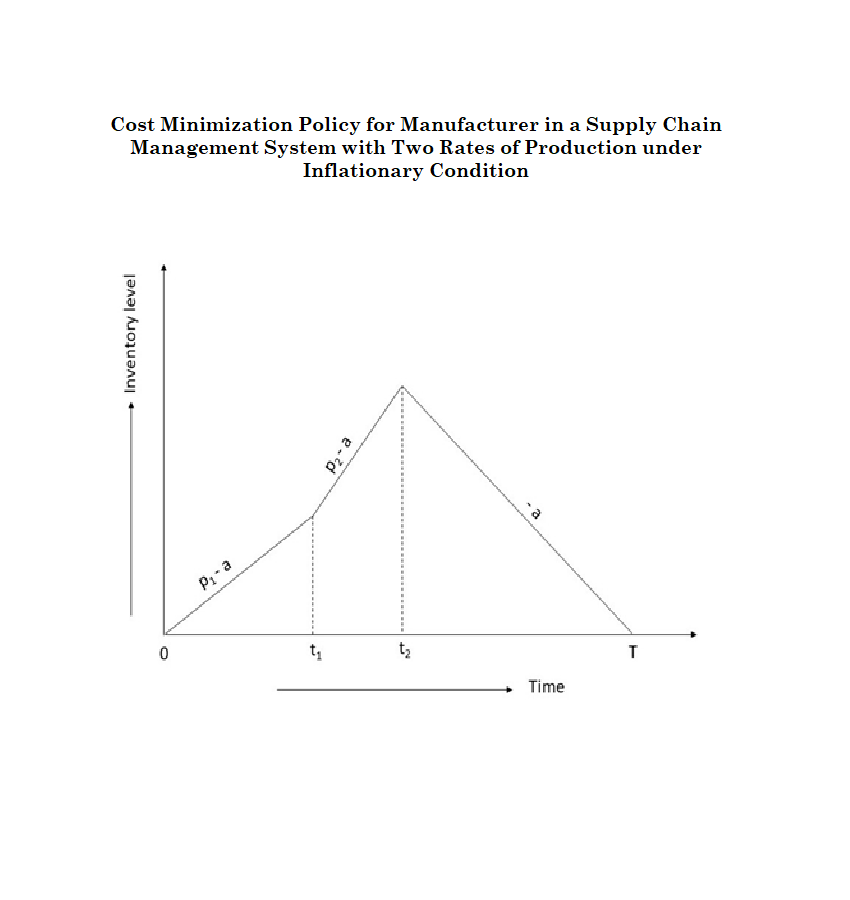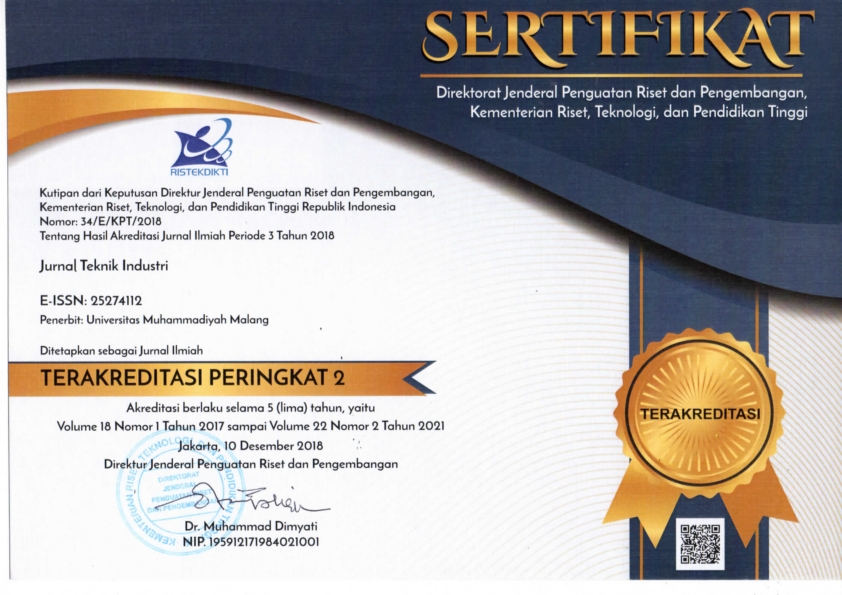Cost Minimization Policy for Manufacturer in a Supply Chain Management System with Two Rates of Production under Inflationary Condition
DOI:
https://doi.org/10.22219/JTIUMM.Vol21.No2.200-212Keywords:
Two rates of production rate, inflation, deterioration, supply chain management, cost minimizationAbstract
This article presents a production inventory model for deteriorating goods with two different rates of production. The manufacturer starts manufacturing the items at a lower rate to avoid a huge investment at the initial stage and reduce the products' holding cost. However, when the stock level reaches a prefixed level, he switches on to a higher production rate to avoid shortage caused by an insufficient stock of the items. Moreover, the impact of inflation and the time value of money on the manufacturing system’s cost is considered here, which harms any business by reducing the value of an investment with time. We determined the optimum production times at both the low and high production rates by minimizing the system's total cost. Numerical examples illustrated the applicability of this proposed model. Sensitivity analysis studied the effect of changes in the parameters associated with this model on the optimal decision variables. This numerical experiment was done in LINGO 18.0 software. Results showed that the production strategy taken by the manufacturer helped reduce his total cost.
Downloads
References
T. K. Datta, "An Inventory Model with Price and Quality Dependent Demand Where Some Items Produced Are Defective," Advances in Operations Research, vol. 2013, p. 795078, 2013. https://doi.org/10.1155/2013/795078.
S. Saha and T. Chakrabarti, An EPQ Model for Deteriorating Items with Probabilistic Demand andVariable Production Rate vol. 7, 2018. https://dx.doi.org/10.13140/RG.2.2.32217.36967.
H. K. Alfares, "Production-inventory system with finite production rate, stock-dependent demand, and variable holding cost," RAIRO-Oper. Res., vol. 48, pp. 135-150, 2014. https://doi.org/10.1051/ro/2013058.
J. Qin, "An EPQ Model with Increasing Demand and Demand Dependent Production Rate under Trade Credit Financing," International Journal of Supply and Operations Management, vol. 2, pp. 532-547, 2015. https://dx.doi.org/10.22034/2015.1.01.
A. Roy and G. P. Samanta, "Inventory model with two rates of production for deteriorating items with permissible delay in payments," International Journal of Systems Science, vol. 42, pp. 1375-1386, 2011. https://doi.org/10.1080/00207721003646256.
J. Bhowmick and G. P. Samanta, "A Deterministic Inventory Model of Deteriorating Items with Two Rates of Production, Shortages, and Variable Production Cycle," ISRN Applied Mathematics, vol. 2011, p. 657464, 2011. https://doi.org/10.5402/2011/657464.
H. Luong and R. Karim, "An integrated production inventory model of deteriorating items subject to random machine breakdown with a stochastic repair time," International Journal of Industrial Engineering Computations, vol. 8, pp. 217-236, 2017. http://dx.doi.org/10.5267/j.ijiec.2016.9.004.
B. K. Mawandiya, J. K. Jha, and J. Thakkar, "Production-inventory model for two-echelon closed-loop supply chain with finite manufacturing and remanufacturing rates," International Journal of Systems Science: Operations & Logistics, vol. 4, pp. 199-218, 2017. https://doi.org/10.1080/23302674.2015.1121303.
Y. Shen, K. Shen, and C. Yang, "A production inventory model for deteriorating items with collaborative preservation technology investment under carbon tax," Sustainability, vol. 11, p. 5027, 2019. https://doi.org/10.3390/su11185027.
R. Keshavarzfard, A. Makui, and R. Tavakkoli-Moghaddam, "A multi-product pricing and inventory model with production rate proportional to power demand rate," Advances in Production Engineering And Management, vol. 14, pp. 112-124, 2019. https://dx.doi.org/10.14743/apem2019.1.315.
N. Kumar, S. Singh, and R. Kumari, "Learning effect on an inventory model with two-level storage and partial backlogging under inflation," International Journal of Services and Operations Management, vol. 16, pp. 105-122, 2013. https://doi.org/10.1504/IJSOM.2013.055575.
V. Gupta and S. R. Singh, "An integrated inventory model with fuzzy variables, three-parameter Weibull deterioration and variable holding cost under inflation," International Journal of Operational Research, vol. 18, pp. 434-451, 2013. https://doi.org/10.1504/IJOR.2013.057485.
R. Uthayakumar and M. Palanivel, "An inventory model for defective items with trade credit and inflation," Production & Manufacturing Research, vol. 2, pp. 355-379, 2014. https://doi.org/10.1080/21693277.2014.893414.
D. Khurana, S. R. Singh, and S. Tayal, "A Supply Chain Production Inventory Model for Deteriorationg Product with Stock Dependent Demand under Inflationary Environment and Partial Backlogging," International Journal of Computer Applications, vol. 131, pp. 6-12, 2015. https://dx.doi.org/10.5120/ijca2015906688.
M. Mondal, A. K. Maity, M. K. Maiti, and M. Maiti, "A production-repairing inventory model with fuzzy rough coefficients under inflation and time value of money," Applied Mathematical Modelling, vol. 37, pp. 3200-3215, 2013. https://doi.org/10.1016/j.apm.2012.07.024.
S. Rani, R. Ali, and A. Agarwal, "Green supply chain inventory model for deteriorating items with variable demand under inflation," International Journal of Business Forecasting and Marketing Intelligence, vol. 3, pp. 50-77, 2017. https://doi.org/10.1504/IJBFMI.2017.082548.
N. Kumar, S. R. Singh, and R. Kumari, "An Inventory Model with Time-Dependent Demand and Limited Storage Facility under Inflation," Advances in Operations Research, vol. 2012, p. 321471, 2012. https://doi.org/10.1155/2012/321471.
M. Palanivel and R. Uthayakumar, "An inventory model with imperfect items, stock dependent demand and permissible delay in payments under inflation," RAIRO-Oper. Res., vol. 50, pp. 473-489, 2016. https://doi.org/10.1051/ro/2015028.
S. Saha, "Fuzzy Inventory Model for Deteriorating Items in a Supply Chain System with Price Dependent Demand and Without Backorder," American Journal of Engineering Research (AJER), vol. 6, 2017.
G. S. Mahapatra, S. Adak, T. K. Mandal, and S. Pal, "Inventory model for deteriorating items with time and reliability dependent demand and partial backorder," International Journal of Operational Research, vol. 29, pp. 344-359, 2017. https://doi.org/10.1504/IJOR.2017.084340.
A. S. Yadav, B. Tyagi, S. Sharma, and A. Swami, "Effect of inflation on a two-warehouse inventory model for deteriorating items with time varying demand and shortages," International Journal of Procurement Management, vol. 10, pp. 761-775, 2017. https://doi.org/10.1504/IJPM.2017.087318.
B. Pal, S. S. Sana, and K. Chaudhuri, "A stochastic production inventory model for deteriorating items with products’ finite life-cycle," RAIRO-Oper. Res., vol. 51, pp. 669-684, 2017. https://doi.org/10.1051/ro/2016047.
C. K. Sivashankari, "Purchasing Inventory Models for Deteriorating Items with Quadratic Demand," Jurnal Teknik Industri, vol. 20, pp. 204-217, 2019. https://doi.org/10.22219/JTIUMM.Vol20.No2.204-217.
S. Saha and T. Chakrabarti, "Two-echelon Supply Chain Model for Deteriorating Items in an Imperfect Production System with Advertisement and Stock Dependent Demand under Trade Credit," International Journal of Supply and Operations Management, vol. 5, pp. 207-217, 2018. https://dx.doi.org/10.22034/2018.3.5.
K. Prasad and B. Mukherjee, "Optimal inventory model under stock and time dependent demand for time varying deterioration rate with shortages," Annals of Operations Research, vol. 243, pp. 323-334, 2016. https://doi.org/10.1007/s10479-014-1759-3.
C. K. Chan, W. H. Wong, A. Langevin, and Y. C. E. Lee, "An integrated production-inventory model for deteriorating items with consideration of optimal production rate and deterioration during delivery," International Journal of Production Economics, vol. 189, pp. 1-13, 2017. https://doi.org/10.1016/j.ijpe.2017.04.001.
S. Banerjee and S. Agrawal, "Inventory model for deteriorating items with freshness and price dependent demand: Optimal discounting and ordering policies," Applied Mathematical Modelling, vol. 52, pp. 53-64, 2017. https://doi.org/10.1016/j.apm.2017.07.020.
A. Khakzad and M. R. Gholamian, "The effect of inspection on deterioration rate: An inventory model for deteriorating items with advanced payment," Journal of Cleaner Production, vol. 254, p. 120117, 2020. https://doi.org/10.1016/j.jclepro.2020.120117.
S. K. D. B. Maulana, D. M. Utama, M. S. Asrofi, I. S. Ningrum, N. Alba, H. A. Ahfa, et al., "The Capacitated Sustainable EOQ Models: Models Considering Tax Emissions," Jurnal Teknik Industri, vol. 21, pp. 12-21, 2019. https://doi.org/10.22219/JTIUMM.Vol21.No1.12-21.
M. F. Ibrahim and M. M. Putri, "Integrated Green Supply Chain Model to Reduce Carbon Emission with Permissible Delay-in-Payment Consideration," Jurnal Teknik Industri, vol. 20, pp. 128-139, 2019. https://doi.org/10.22219/JTIUMM.Vol20.No2.128-139.
S. Saha and T. Chakrabarti, "A supply chain model under return policy considering refurbishment, learning effect and inspection error," Croatian Operational Research Review, vol. 11, pp. 53-66, 2020. https://doi.org/10.17535/crorr.2020.0005.

Downloads
Published
How to Cite
Issue
Section
License
Copyright (c) 2020 Sujata Saha, Tripti Chakrabarti

This work is licensed under a Creative Commons Attribution-ShareAlike 4.0 International License.











